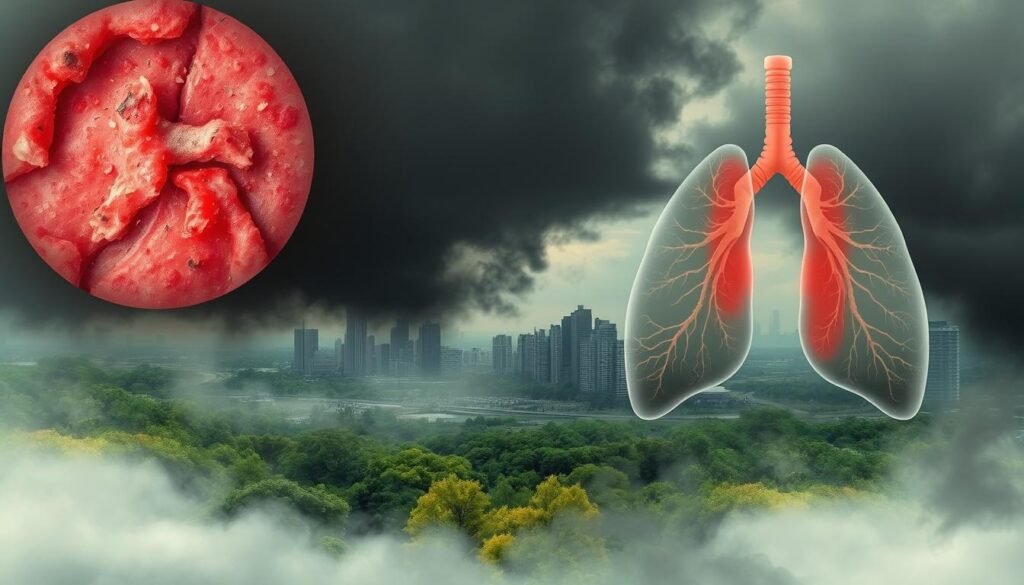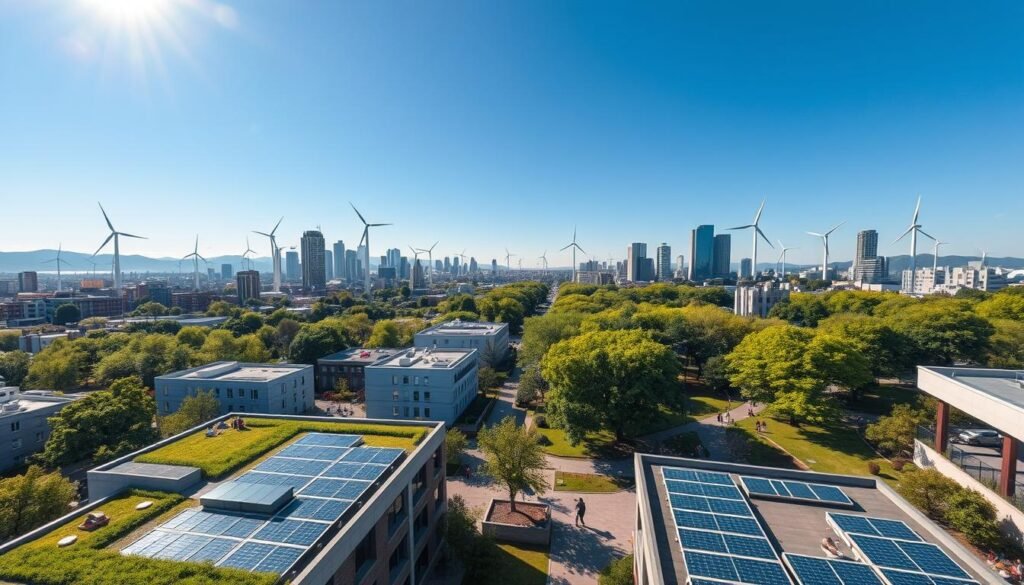Did you know around 100 million people in the U.S. are living in places with too much air pollution? This fact points out the big worry about air quality being a major risk to our health. Every year, air pollution causes more than 6.5 million deaths worldwide.
This pollution comes from natural and human activities, like car smoke and factories. It can badly affect communities’ health.
To truly understand air pollution, we need to look at how it affects us. It can cause many health problems, from breathing issues to heart disease. Learning about air pollution helps us know how to lessen its impact and keep people healthy.
Talking about pollution, it’s important to see how it hits our health. It doesn’t just hurt us physically but worsens existing health issues too. This leads to thousands going to the hospital every year.
The clear connection between air quality and health shows we need better rules and green practices. This urgency is something we can’t ignore.
Key Takeaways
- Over 100 million people in the U.S. live in areas with unsafe air pollution levels.
- Air pollution causes over 6.5 million deaths globally each year.
- Short-term exposure to particulate pollution can lead to immediate health risks and morbidity.
- Long-term exposure to PM2.5 increases risks for respiratory and cardiovascular diseases.
- Improving air quality can significantly enhance respiratory health, particularly in children.
- Environmental policies and sustainability initiatives are critical in combating air pollution.
Understanding Air Pollution: Definitions and Sources
Air pollution means harmful substances in the atmosphere affect our health and environment. It includes toxins like carbon monoxide and nitrogen oxides. Knowing about air pollution is key for good outdoor air quality.
Many things cause air pollution, such as:
- Vehicle emissions
- Industrial processes
- Agricultural practices
- Natural events like wildfires
Cities often face more air pollution because of more people and factories. In 2019, outdoor air pollution was linked to 4.5 million deaths worldwide. Deaths from indoor pollution were also high. As cities expand, it’s vital to manage air quality better.
Air quality getting worse over time harms our health. Health groups stress the need to check pollution levels. The impact of outdoor air quality is a big deal. It shows why we need cleaner technology and laws.
Studies show that fine dust in the air (PM2.5) causes health issues. This includes breathing problems and more deaths. While carbon dioxide and methane add to global warming, particulate matter poses a high health risk. Knowing where pollution comes from is crucial in fighting it.
| Source of Air Pollution | Types of Pollutants | Health Effects |
|---|---|---|
| Vehicle Emissions | Nitrogen oxides, Carbon monoxide | Asthma, respiratory infections |
| Industrial Processes | Particulate matter, Sulfur dioxide | Cardiovascular diseases, cancer |
| Agricultural Practices | Ammonia, Pesticides | Respiratory problems, skin issues |
| Wildfires | Smoke, Particulates | Lung damage, increased mortality |
To handle air pollution well, we need a thorough plan that combines research and action. Reducing pollution sources can make cities healthier.
Health Impacts of Air Pollution
Air pollution has deep and wide-ranging effects on health, causing global concern. Each year, around 9 million people die too soon from man-made air pollution. This shows how critical it is to tackle this problem. One major area affected is our lungs. Long-term contact with pollutants, like fine particulate matter (PM2.5), can cause chronic asthma and other serious lung diseases.
Besides harming our lungs, air pollution also damages our hearts. Studies show a direct link between heart health and air pollution levels. This link puts many people, especially in vulnerable groups, at risk. In developing countries, women face greater dangers due to indoor air pollution from cooking and heating.
In places like China and India, air pollution is a big reason for lung cancer deaths. Developed countries are also seeing more heart diseases due to bad air. Tiny particles we breathe in, including sulfates, are a major concern. This underscores the urgent need for better air quality plans.
Nearly all city dwellers, 97% to be exact, breathe air that’s more polluted than what’s considered safe. This fact highlights the urgent need for actions to protect our health and clear the air.
Air Pollution and Environmental Exposure: Health Effects
Air pollution is a major health threat. It impacts many chronic conditions. Knowing the risks helps us prevent and stay aware.
Respiratory Health Risks
Polluted air greatly affects our respiratory health. It makes conditions like asthma and COPD worse. The fine dust in cities raises these health risks. In 2019, many deaths from respiratory diseases were linked to dirty air. This shows how important clean air is for our health.
Cardiovascular Diseases
Being around polluted air for a long time links to more heart disease risks. About 68% of deaths from air pollution are due to heart issues and strokes. The tiny particles in dirty air can get into our blood. This raises the chance of heart attacks and strokes. Those with less health care access suffer even more from these problems.
Cancer Associations
Research shows a scary link between air pollution and cancer. Tiny dust particles in the air are known to cause lung cancer. Those living near factories have a higher risk of getting cancer. Strong laws and clean tech are vital to lower these risks and keep us healthy.
The Role of Particulate Matter in Air Quality
Particulate matter, often called PM, is tiny bits or droplets in the air that threaten our health. There are two types, PM2.5 and PM10, both harmful but in different ways. Knowing about them helps communities understand why clean air is crucial.
What is Particulate Matter?
PM includes fine particles smaller than 2.5 micrometers (PM2.5) and coarse particles sized between 2.5 and 10 micrometers (PM10). PM2.5 can go deep into the lungs, causing serious harm. These particles come from cars, factories, and even wildfires.
Health Effects of PM2.5 and PM10
Being around particulate matter can cause health problems, which depend on the particle size. Short-term contact with PM2.5 can lead to emergency hospital visits for lung diseases. People with heart or lung issues, like asthma, are at an even higher risk from PM2.5.
PM10’s effects are also alarming. Being exposed in the short term can worsen asthma and COPD. The long-term impacts are less clear but might include increased risk of dying from lung disease.
| Particle Type | Diameter | Short-term Effects | Long-term Effects |
|---|---|---|---|
| PM2.5 | 2.5 micrometers or less | Increased hospital admissions, asthma attacks | Premature death, reduced lung function growth in children |
| PM10 | 10 micrometers or less | Worsening respiratory diseases like asthma | Potential link to respiratory mortality |

Particulate matter harms more than just our health. It makes it harder to see far and plays a part in global climate change. By understanding PM2.5 and PM10’s health impacts, we can work on improving air quality. This will protect everyone, especially those most at risk.
Smog and Ground-Level Ozone: Major Threats
Smog is made mostly of ground-level ozone. It forms when pollutants from cars and factories react with sunlight. These pollutants cause major air quality threats. Places like Sequoia and King’s Canyon National Parks have very high ozone levels. This is mainly because smog comes from cities.
Ground-level ozone isn’t just annoying. It harms our health and the environment. High ozone levels can hurt our lungs, make heart disease worse, and even lead to death. Every year, over one million people die too early because of ozone. It also hurts plants, making them grow poorly and reducing photosynthesis. This could mean less wheat, soybeans, and corn by 2050.
Climate change could make ozone problems worse. Warmer temperatures might lead to more ozone. Despite efforts to reduce emissions, the U.S. still struggles with ozone pollution.
Ground-level ozone also threatens different plant types. Plants like black cherry and quaking aspen are very sensitive to it. If we ignore this, we could see a big loss in plant variety.
| Impact | Details |
|---|---|
| Health Risks | Increased respiratory issues and higher rates of heart disease |
| Global Premature Deaths | Over 1 million per year attributed to high ozone levels |
| Food Production Decline | Wheat by 13%, soybeans by 28%, and corn by 43% by 2050 |
| Biodiversity Threats | Damage to various plant species affecting ecosystem resilience |
| Climate Change Contribution | Higher temperatures increase ground-level ozone formation |
We need to work together to deal with these problems. Stricter rules on emissions, better public understanding, and actions to limit ozone are essential. Without effort, the impact on health, farming, and nature will get much worse.
Climate Change and Air Quality
The link between climate change and air quality affects our health globally. Air pollutants and greenhouse gases make climate problems worse. They are influenced by global temperature rises. Understanding this relationship helps us find better ways to protect our planet.
How Air Pollutants Contribute to Climate Change
Air pollutants, like methane, speed up climate change. Methane is 84 times more potent than CO2 at warming the earth over 20 years. It helps create more ground-level ozone, which is bad for the air we breathe. Black carbon from fine particulate matter also warms our planet. It does this by making ice and snow melt faster.
Effects of Climate Change on Air Pollution
Climate change makes air pollution worse in several ways. For example, warmer temperatures increase dangerous ground-level ozone. This can harm our lungs. Also, big wildfires caused by extreme weather release more pollutants. The National Climate Assessment says these changes will increase health risks. This is because they raise the levels of particulate matter in the air, affecting those who are most vulnerable.

| Air Pollutants | Climate Change Contribution | Health Impacts |
|---|---|---|
| Methane | 84 times more potent than CO2 | Respiratory issues, worsened air quality |
| Black Carbon | Accelerates melting of snow and ice | Increased cardiovascular risks |
| Ground-Level Ozone | Formation increased by rising temperatures | Breathing difficulties, lung diseases |
| Particulate Matter | Higher concentrations with climate alterations | Heart disease, stroke, lung cancer |
We must address air pollution and climate change with strong policies. Reducing emissions from cars and factories can fight climate change and make our air healthier. We need a solid plan to face these challenges together.
Vulnerable Populations Affected by Air Pollution
Air pollution hits vulnerable groups hard, leading to poor health conditions. Children and low-income individuals face greater dangers due to their environments. Many live in highly polluted areas, worsening health problems and making healthcare hard to get.
Children and Air Quality
Children are extremely at risk from air pollution. Their immune systems are still developing, making them more likely to get sick. An estimated 29.2 million kids live in counties with poor air quality ratings for certain pollutants. Asthma impacts 1.9 million of these children. Polluted air can cause long-lasting harm and significant health issues in kids. For more details, visit here.
Impacts on Low-Income Communities
Low-income areas suffer more from air pollution due to various factors. Around 16 million people in poverty live in highly polluted counties. And 5.4 million are in places failing all pollution standards. This results in more illnesses like respiratory and heart diseases. Living near busy roads or industrial areas increases their risk. Also, poor indoor air from using low-quality fuels for cooking and heating adds to the problem.
There’s a critical need for actions and policies to help these vulnerable groups. This includes improving air quality and making health resources fairer. We must work to lessen pollution’s harmful effects on children and low-income communities.
| Population | Count | Pollution Impact |
|---|---|---|
| Children under 18 | 29.2 million | Living in counties with failing grades for at least one pollutant |
| Adults aged 65 and over | 20.6 million | Residing in counties with failing grades for pollution |
| Individuals in poverty | 16 million | Living in counties graded F for at least one pollutant |
| Asthma cases in children | 1.9 million | Residing in counties with failing grades |
| Asthma cases in adults | 9.8 million | In counties graded F for at least one pollutant |
| Pregnancies in polluted areas | 1.4 million | Recorded in 2022 in counties with at least one failing grade |
Environmental Regulations and Policies
The progress in air quality rules has helped public health and the environment greatly. Initial steps were to make air quality rules tough. This has grown to include many policies to cut down harmful emissions.
Historical Overview of Air Quality Legislation
California has led in making laws for air quality and health. In 1959, it made laws for the Department of Public Health to set air quality standards. This started a trend for tougher rules. The California ambient air quality standards (CAAQS) are stricter than national levels. This shows California’s commitment to tough environmental policies.
Over time, these standards have been updated for particulate matter, ground-level ozone, and nitrogen dioxide. These changes make sure communities are safe from the health risks of these pollutants.
Achievements and Ongoing Challenges
Even with big steps forward, problems remain. Almost half of Americans still breathe bad air. People of color are affected more by this. This shows that air quality laws need to specifically help those facing these issues. The SmartWay program is an example of trying to lower emissions from transport.
Yet, political backing for these laws doesn’t always stay strong. Adapting to new sources of pollution is key for future success in air quality rules.

Sustainable Practices to Reduce Air Pollution
Adopting sustainable practices is key to fighting air pollution. A lot of air pollution comes from cars and trucks. This is especially true in cities like California. Here, about half of the pollution is due to these vehicles. Encouraging people to walk or bike can greatly reduce air pollution from vehicles. Slowly accelerating and following speed limits also helps make vehicles more eco-friendly.
Getting regular check-ups for your car is important. It can help lower emissions. For example, keeping tires well-inflated helps. Try to keep vehicle idling under 30 seconds to save fuel and cut down emissions. At home, using energy-saving practices is crucial for environmental sustainability. Turn off lights when they’re not needed. Use energy-efficient bulbs and fans over air conditioning to lower energy use.
Recycling helps reduce air pollution too. It cuts pollution by reducing the need for new materials. For example, low-flow showerheads save water and energy needed to heat that water. Choosing eco-friendly products, like those made from bamboo, reduces our environmental impact.
Community support for EPA-approved wood stoves lowers emission from heating our homes. Opting for propane grills over charcoal ones reduces pollutants. Using washable dishes instead of throwaway ones also lowers waste and emissions from making those products.
Planting trees improves air by filtering pollutants. Carpooling and working from home can greatly lower emissions from vehicles. Encouraging recycling at work helps the planet and reduces waste. Printing on both sides of paper and turning equipment off saves energy and reduces emissions.
| Sustainable Practices | Impact on Air Pollution |
|---|---|
| Walking or Biking | Reduces vehicle emissions significantly |
| Proper Vehicle Maintenance | Lower emissions and environmental footprint |
| Energy-Efficient Lighting | Decreases electricity usage |
| Recycling | Minimizes pollution associated with manufacturing |
| Planting Trees | Improves air quality |
These sustainable actions help us all help the environment. They make our communities cleaner and healthier for the future. By doing these things, we make a big difference in local and global environmental health.
Conclusion
Air pollution is a big problem for both our health and the environment. Developed countries have made progress in reducing it. But, developing countries like China and India still face high pollution levels. This pollution is linked to higher death rates from diseases like lung cancer. Understanding this can help communities and leaders take steps towards better health.
The World Health Organization has set new rules for air quality. They are calling for stricter limits on pollutants like PM, SO2, NO2, and O3. Even with these guidelines, air pollution is still a risk. Studies show that being exposed to polluted air can lead to health problems, both short and long term.
To fight air pollution, we need a plan that includes education, new policies, and action from everyone. People need to know how air pollution affects health. This knowledge can help everyone push for cleaner air. This will protect us now and future generations from the harmful effects of air pollution. For more on health risks, like how allergies and lung cancer are connected, click here.